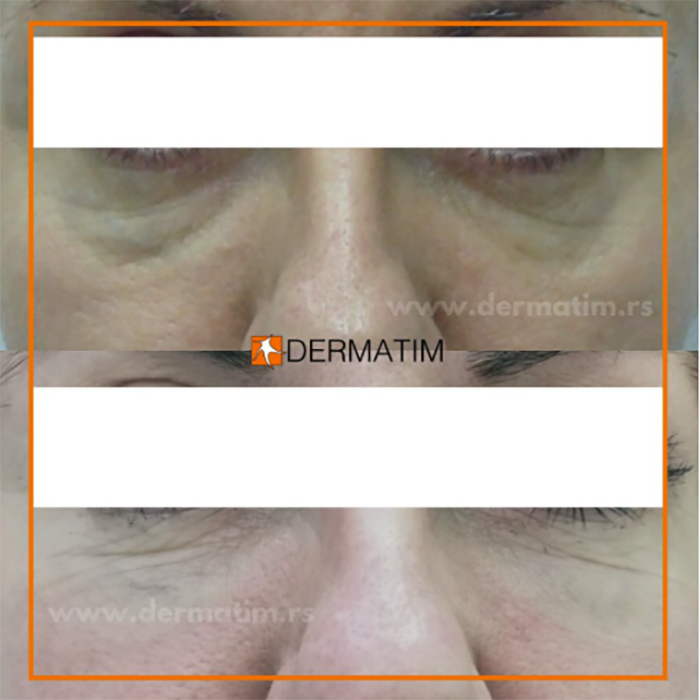Under-eye correction is a complex area of aesthetic medicine involving a great deal of responsibility. It requires experienced doctors as well as a number of appropriate techniques.
Under-eye skin is 0.5 mm thick and the muscle is 1 mm thick. Subcutaneous tissue is minimal and rests on the bone. The anatomy of this region is such that it does not allow for error because even the slightest error would be apparent.
Under-eye circles or sunken eyes show fatigue and “add years to patient’s age”, which is why this is one of the most important areas for eliminating facial fatigue.
Tear trough is an anatomical term for the groove under the eyes that starts from the nose and descends linearly towards the middle of the cheek. It gives the appearance of a dark under-eye circle and with age it becomes increasingly expressive.
Even with a pronounced under-eye bag, this groove is further emphasized and gives the eye a tired look.
Under-eye treatment

Under-eye correction differs depending on whether the patient has bags on the under-eye area or sunken eyes.
Under-eye circle with pronounced bag
Under-eye circles can be completely removed surgically. A small incision under the eyelashes or on the inside of the eye mucous membrane allows access to the fat tissue of the under-eye circle. Fat tissue is completely removed and the patient can perform his or her usual activities 7 days after the intervention.
If the patient does not wish to undergo surgery, non-surgical removal of under-eye circle is also possible.
It is necessary to combine several techniques to obtain an adequate result.
Radiofrequency lifting is a method of applying a radio wave probe inside the under-eye bag. A temperature of 45 to 48 degrees is applied for 3 minutes. Over the next three months, the under-eye tissue gradually melts and the skin becomes firmer. When fat in the bag is reduced, considerably fewer amount of fillers is needed.
Carboxytherapy is a non-aggressive method of removing or reducing under-eyecircles. It involves application of gas, carbon dioxide, to the desired area. After a certain number of treatments, neovascularization and intensive lymphatic drainage occur, which results in under-eye circle being less visible.
Hyaluronic acid is a powerful tool in the reduction of under-eye circles that gives immediately visible results. Attention should be paid to the anatomy and age of each patient. In almost 80% of patients, it is necessary to tighten all the ligaments of the surrounding facial region in order to provide adequate support to the eye area. Only after that, the eye groove itself should be treated. Hyaluronic acid must have an adequate density, adapted to the delicate and thin area of the eye groove. The experience of the doctor allows the material to be applied in an adequate layer so it does not appear like a sausage around the eye, especially when smiling. This area is full of blood vessels, so it is desirable to perform the procedure using a cannula. The bluishness that appears after the application of hyaluronic acid using a needle disappears within two weeks. Inadequately applied hyaluronic acid filler looks bloated, closes and shrinks the eye and swells after sleeping. If this occurs, it is necessary to melt it, because it takes years and even a decade for it to disappear.
PRP is a treatment that uses a patient’s own blood cells. It cannot reduce the under-eye circle, but it strongly stimulates elastin and gives support to the under-eye bag.
Under-eye circle without pronounced bag
The under-eye area without fat tissue in the bag is pronounced if there is a deep groove around the eyes. It is genetically predisposed, and as the eyes fall into the eye sockets with age, it becomes increasingly pronounced.
Dark under-eye rings occur with circulatory disorders in this region as well as with additional loss of fat tissue. In the procedures, it is necessary to rejuvenate the skin around the eyes and fill the lacking fat tissue.
Just one fractional CO2 laser treatment can regenerate the skin around the eyes. It takes 4 days to recover. A mild swelling and minimal flaking of the area occur during this recovery period. The results are visible immediately, and after 3 months, additional stimulation of collagen takes place. The skin becomes smooth, radiant, and wrinkles are significantly reduced.
Hyaluronic acid fillers compensate for fat tissue. They are placed precisely under the skin of the under-eye groove and give freshness to the eye immediately after the treatment. The final result is obtained two weeks to one month after application.
Fat tissue can be used as a filler in this area. A slightly longer recovery is required because the fat is applied using thicker cannulas and it is much rougher than hyaluronic acid. Hyaluronic acid applied in this region is long-lasting, sometimes up to 2 years, so fat tissue is indicated only if there is a large defect.
Chemical peels can help achieve adequate under-eye circle colour, especially TCA peels.
Q switch laser in combination with CO2 laser is a powerful means for pigment reduction. Recovery takes 7 days because the skin gets a darker shade for a few days. After 7 days, additional collagen stimulation takes place, which is generated by both lasers, the non-ablative Q switch laser and the ablative fractionated CO2 laser.
References:




